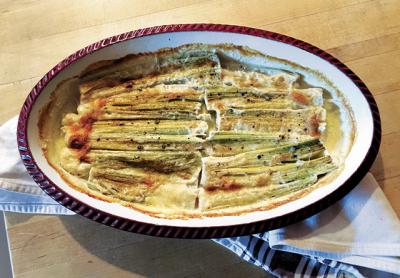Seasons by the Sea: Variations on the Theme

The first Thanksgiving of 1621 was simply referred to as a harvest celebration. An Englishman named Edward Winslow described it in a letter to a “loving, and old friend”:
“I never in my life remember a more seasonable year, than we have here enjoyed — for fish and fowl we have a great abundance, fresh cod in the summer — our bay full of lobsters, all the springtime the earth sendeth forth naturally good salad herbs: Here are grapes, white and red, very sweet and strong also.”
He goes on to describe the success of his fellow setllers’ 20 acres of Indian corn and six acres of barley and peas, which the Wampanoag Indians had taught them to fertilize with herring.
On that day, for approximately 150 people, the men hunted waterfowl, most likely duck, geese, swans, passenger pigeons, and wild turkey. The chief, or “sachem” Massasoit (incorrectly referred to by the English as the king) brought five deer, which sustained everyone for a three-day feast. There was also likely plenty of eel, shellfish, lobster, clams, and mussels, which were smoked. The smaller birds were spit-roasted and the bigger ones probably boiled. There may have also been Jerusalem artichokes, chestnuts, Indian turnips, water lily, and sweet flag. Sweet flag is a wetland grass similar to rush or cattails, but it can cause lethargy and hallucinations, so that might have made it a swell party.
The Wampanoag (People of the Dawn) tribe was already growing the “three sisters” — corn, beans, and squash — and harvested chestnuts, walnuts, and beechnuts from the forest. Winslow found them to be “very trusty and ripe-witted.” He said that one could walk as peaceably and safely through the woods of Plymouth as the highways of England.
The Wampanoag Indians lived under a matrilineal and matrifocal system. The women controlled and farmed the land, the land was inherited by the daughter, and married couples lived with the daughter’s mother. The women would choose the chiefs or sachems and the men would deal with other tribes. The men would hunt and fish, but the women were still responsible for about 75 percent of their food.
How did the first harvest celebration of 1621 become Thanksgiving, with marshmallow smothered sweet potatoes, pumpkin pie, and creamed onions? A Boston clergyman named Alexander Young reprinted Winslow’s letter in his “Chronicles of the Pilgrim Fathers” and arbitrarily dubbed the feast the first Thanksgiving.
Potatoes and sweet potatoes were not to arrive from South America and the Caribbean until many years later. The discovery of boiling cranberries with sugar to make a sauce “that’s good with meat” came about 50 years later.
Sarah Josepha Hale is the one who deserves credit for making Thanksgiving a yearly event. She was the editor of a popular women’s magazine called “Godey’s Lady’s Book,” which instructed women on how to run a household, kind of an early Martha Stewart. She started petitioning presidents in 1827, and by the time Abraham Lincoln and our country were in the midst of the Civil War, he declared it a national holiday in the hopes of uniting the country. Hale had also published almost a dozen cookbooks with such recipes as roast turkey with sage dressing, mashed potatoes, and creamed onions, so when housewives heard the clarion call, they were ready to cook.
A lot of us serve the same things over and over at Thanksgiving, probably because that’s what we grew up with. I am not ashamed to say I still love mashed sweet potato casserole with mini marshmallows on top, and I tend to scrape most of those sugary, burnt bits onto my plate, leaving the vegetable matter behind. But sometimes it’s fun to mix it up, make something different, or just come up with a variation on a classic.
Last year I brought Ina Garten’s twice-baked sweet potatoes with Taleggio cheese to a friend’s house, and it didn’t go over very well. I think it was the funky, assertive odor of the Taleggio. Perhaps I strayed too far from everyone’s beloved classics. This year I am going with Bobby Flay’s sweet potatoes with chipotle casserole, something I make year round that is staggeringly delicious. I am also going to make leeks baked in cream, something that pairs well with any fowl. I also found a recipe for mashed potatoes with caramelized onions and Gruyere cheese that sounds lighter than most cream and butter-laden versions.
For dessert I plan to experiment with ice cream to go with pie. I am going to puree about half a cup of fresh cranberries with orange zest and fold it into slightly defrosted vanilla ice cream and refreeze it. It will be a pretty pink, slightly tart, and citrusy. I hope.
I will not be home for Thanksgiving, but I will be with family and dear friends. We will reflect on the history of our young country, give thanks for what we have, and, uh, please pass the sweet flag.
Click for recipes
